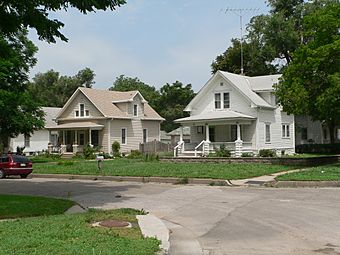South Bottoms Historic District facts for kids
Quick facts for kids |
|
|
South Bottoms Historic District
|
|

Houses on B Street
|
|
| Location | Roughly bounded by M and J and H and G Sts., Second and Ninth Sts., and W. B Sts., and Salt Creek, Lincoln, Nebraska |
|---|---|
| Area | 264 acres (107 ha) |
| Architect | Rohrig, Jacob; Et al. |
| NRHP reference No. | 86001717 |
| Added to NRHP | July 17, 1986 |
The South Bottoms Historic District is a special neighborhood in Lincoln, Nebraska. It's known for its many old houses and buildings. This area was mostly settled by people called Volga Germans a long time ago. They came here in the late 1800s and early 1900s.
Contents
What is the South Bottoms Historic District?
The South Bottoms Historic District is a residential area. This means it's a place where people live. It has over 1,000 buildings that are important to its history. These are called "contributing structures." There are also some newer buildings that are not part of the original history.
The houses in this area are mostly single-family homes made of wood. You can also find some shops on F Street. The buildings mix American building styles with traditions from Russia. This is because of the people who settled here.
Who Lived Here? The Volga Germans
The area along Salt Creek became home to Volga Germans starting in the 1870s. They were immigrants who came from villages near the Volga River in Russia. They chose this area because the houses were not expensive. This was important for new families.
People from the same Russian villages often lived close to each other. For example, the "Norker Bottom" part of the neighborhood was settled by families from villages like Norka and Huck. The "Franker Bottom" section had people from Frank and Balzer.
Many of these immigrants were farmers. Because of this, many people from South Bottoms worked in sugar beet fields. They would often work there from May to November each year.
What Do the Houses Look Like?
Houses in the South Bottoms neighborhood have some common features. Many have porches at the front or side. They are built on raised foundations made of concrete blocks. The porch supports are often made of stone. Most houses also have "hipped roofs," which means the roof slopes down on all four sides.
You can also find several churches in the neighborhood. These churches were important gathering places for the community.
A Special Place: National Register of Historic Places
The South Bottoms Historic District is a very important place. It was added to the National Register of Historic Places on July 17, 1986. This is a list of places in the United States that are important to history. Being on this list helps protect the neighborhood and its unique story.



